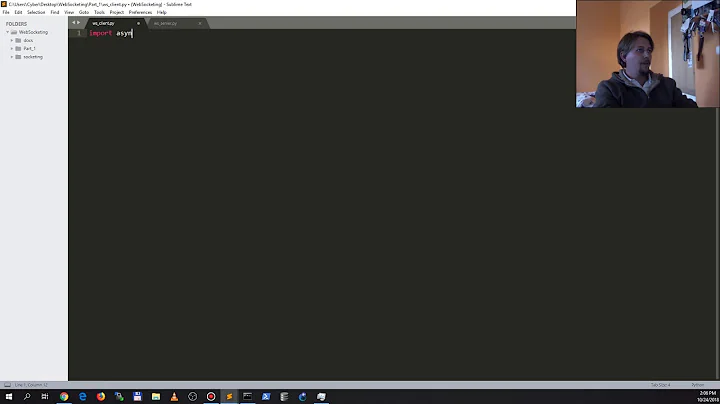How can I implement asyncio websockets in a class?
How to write async programs?
- You should define async funcs with
async - You should call async
funcs with
await - You need event loop to start your async program
All other is almost same as with regular Python programs.
import asyncio
from websockets import connect
class EchoWebsocket:
async def __aenter__(self):
self._conn = connect("wss://echo.websocket.org")
self.websocket = await self._conn.__aenter__()
return self
async def __aexit__(self, *args, **kwargs):
await self._conn.__aexit__(*args, **kwargs)
async def send(self, message):
await self.websocket.send(message)
async def receive(self):
return await self.websocket.recv()
async def main():
async with EchoWebsocket() as echo:
await echo.send("Hello!")
print(await echo.receive()) # "Hello!"
if __name__ == '__main__':
loop = asyncio.get_event_loop()
loop.run_until_complete(main())
Output:
Hello!
As you see, code is almost same as you wrote.
Only difference is that websockets.connect designed to be async context manager (it uses __aenter__, __aexit__). It's necessary to release connection and will also help you to make async operations during class initialization (since we have no async version of __init__).
I advise you to organize your class same way. But if you really don't want to use context manager for some reason you can use new __await__ method to make async initialization and some other async function to release connection:
import sys
import asyncio
from websockets import connect
class EchoWebsocket:
def __await__(self):
# see: http://stackoverflow.com/a/33420721/1113207
return self._async_init().__await__()
async def _async_init(self):
self._conn = connect("wss://echo.websocket.org")
self.websocket = await self._conn.__aenter__()
return self
async def close(self):
await self._conn.__aexit__(*sys.exc_info())
async def send(self, message):
await self.websocket.send(message)
async def receive(self):
return await self.websocket.recv()
async def main():
echo = await EchoWebsocket()
try:
await echo.send("Hello!")
print(await echo.receive()) # "Hello!"
finally:
await echo.close()
if __name__ == '__main__':
loop = asyncio.get_event_loop()
loop.run_until_complete(main())
Many examples of using websockets you can find in it's docs.
Related videos on Youtube
2Cubed
Python fanatic, night-owl, and lover of beautiful code. "Don't undertake a project unless it is manifestly important and nearly impossible." -Edwin Land
Updated on September 23, 2022Comments
-
 2Cubed over 1 year
2Cubed over 1 yearI would like to connect to a websocket via
asyncioandwebsockets, with a format as shown below. How would I be able to accomplish this?from websockets import connect class EchoWebsocket: def __init__(self): self.websocket = self._connect() def _connect(self): return connect("wss://echo.websocket.org") def send(self, message): self.websocket.send(message) def receive(self): return self.websocket.recv() echo = EchoWebsocket() echo.send("Hello!") print(echo.receive()) # "Hello!" -
 Alex over 6 yearsthis closes after it received a reply. How could it continue receiving messages?
Alex over 6 yearsthis closes after it received a reply. How could it continue receiving messages? -
 Mikhail Gerasimov over 6 years@FeedTheWeb just keep receiving replies inside context manager.
Mikhail Gerasimov over 6 years@FeedTheWeb just keep receiving replies inside context manager. -
HJA24 about 4 years@MikhailGerasimov I don't understand the above comment. How do you make sure that the script doesn't end after one reply? Thanks
-
 Mikhail Gerasimov about 4 years@HJA24 if you want to send/receive data constantly, you usually start a server. For example, look at a code snippet here, specifically line
Mikhail Gerasimov about 4 years@HJA24 if you want to send/receive data constantly, you usually start a server. For example, look at a code snippet here, specifically lineserver.serve_forever(). Concrete way to start a server depends on what you want to achieve. Popular high-level library to start servers that works with asyncio is aiohttp. It provides a way to work with many protocols including websockets. -
HJA24 about 4 years@MikhailGerasimov hi, I am following the docs of a different source where they don't use
server.serve.forever(), so I am a little bit confused. Can you take a look at my question on SO stackoverflow.com/questions/61216022/…






